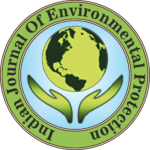IJEP 42(5): 624-630 : Vol. 42 Issue. 5 (May 2022)
B.V. Ramanamurthy and B. Vijayasaradhi*
Andhra University, College of Engineering, Department of Civil Engineering, Visakhapatnam – 530 003, Andhra Pradesh, India
Abstract
Morphometric analysis describes the nature of the land formation on the earth’s surface in the form of linear, aerial, and relief aspects. The morphometric analysis also helps in any hydrological investigation, like groundwater potential, quality and basin assessment and management. The present study carried out linear and aerial aspects of upstream Thandava reservoir located in Visakhapatnam district, Andhra Pradesh state, India. Alongwith field visit, remote sensing techniques and GIS software (Arc GIS 10.3) have been used in this study for the extraction of accurate data and analysis. Satellite images and Shuttle Radar Topographic Mission (SRTM) data had downloaded from USGS (earthexplorer.usgs.gov) have been taken as inputs for the performance of GIS outcomes. GIS has classified the study area into four sub-basins and the morphometric parameters have been computed using standard formulae. The micro-watersheds in an area less than 5 km2 have not been taken into account for analysis and based on the correlation of parameters of the basins the character of basins have shown in this study. Finally, by giving prioritization to the sub-basins, we could take sustainable measures for soil–water conservation, erosion control activities and flood risk mitigation at the right locations in the study area for improved planning and management.
Keywords
Morphometric analysis, Shuttle Radar Topographic Mission, USGS, Micro-watershed, Basin, Remote sensing, Geographical information system
References
- Singh, S. and M.C. Singh. 1997. Morphometric analysis of Kanhar river basin. Natl. Geogr. J. India. 43:31-43.
- Horton, R. 1945. Erosional development of streams and their drainage basisn : Hydrophysical approach to quantative morphology. Geol. Soc. America Bull., 56(3):275-370.
- Strahler, A.N. 1952. Dynamic basis of geomorphology. Geol. Soc. America Bull., 63:933-938.
- Strahler, A.N. 1957. Quantitative analysis of watershed geomorphology. American J. Sci., 248:655-668.
- Strahler, A.N. 1964. Quantitative geomorphology of drainage basin and channel networks. In Handbook of applied hydrology (vol 63). pp 439-476.
- Miller, V. 1953. A quantitative geomorphic study of drainage basin characteristics in the clinch mountain area, Virginia and Tennessee. Project NR 389-402. Technical report 3. Department of Geology, Columbia University, New York, U.S.A.
- Martins, A.K. and B.L. Gadiga. 2015. Hydrological and morphometric analysis of upper Yedzaram catchment of Mubi in Adamawa state, Nigeria using geographic information system (GIS). World Env., 5(2):63-69.
- Yadav, S.K., et al. 2014. Morphometric analysis of upper Tons basin from northern foreland of peninsular India using CARTOSAT satellite and GIS. Geocarto. Int., 29(8):895-914.
- Poongodi, R. and S. Venkateswaran. 2018. Prioritization of the micro-watersheds through morphometric analysis in the Vasistha sub-basin of the Vellar river, Tamil Nadu using ASTER digital elevation model (DEM) data. Data Brief. 20:1353-1359.
- Magesh, N.S., et al. 2011. Morphometric evaluation of Papanasam and Manimuthar watersheds, part of Western Ghats, Tirunlveli district, Tamil Nadu, India : A GIS approach. Env. Earth Sci., 64:373-381.
- Arabameri, A., et al. 2020. Morphometric analysis for soil erosion susceptibility mapping using novel GIS-based ensemble model. Remote Sens., 12 (5):874.
- Singh, A.P., et al. 2020. Morphometric analysis of Ghaghara river basin, India using SRTM data and GIS. J. Geol. Soc. India. 95:169-178.
- Prasad, R.K., et al. 2008. Deciphering potential groundwater zone in hard rock through the application of GIS. Env. Geol., 55:467-475.
- Raja, D.L., et al. 2020. Morphometric and landuse analysis to estimate flood hazard-A case study of upper Cimanuk watershed in Garut regency, Indonesia. Int. J. Geomate., 19(73):126-133.
- Schumn, S.A. 1956. Evaluation of drainage systems and slopes in badland at Perth Amboy, New Jersey. Geol. Soc. America Bull., 67:597-646.
- Altaf, F., et al. 2013. Morphometric analysis to infer hydrological behaviour of Lidder watershed, western Himalaya, India. Geogr. J., 1-14. DOI: 10.115/2013/178021.
- Waiyasusri, K. and S. Chotpantarat. 2020. Watershed prioritization of Kaeng Lawa sub-watershed, Khon Kaen Province using the morphometric and landuse analysis : A case study of heavy flooding caused by tropical storm podul. Water. 12(6):1-23.
- Smith, K. 1950. Standards for grading textures of erosional topography. American J. Sci., 248:655-668.
- Sujatha, E.R., et al. 2015. Morphometric analysis of sub-watershed in parts of Western Ghats, South India using ASTER DEM. Geomat. Nat. Hazards Risk. 6:326-341.
